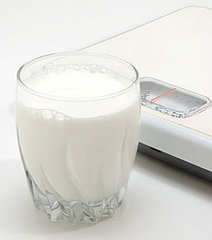 A new simulation model predicts weight changes with varying diets and exercise plans. Researchers at the National Institutes of Health (NIH) have created a mathematical model — and an accompanying online weight simulation tool — of what happens when people of varying weights, diets and exercise habits try to change their weight. The findings challenge the commonly held belief that eating 3,500 fewer calories — or burning them off exercising — will always result in a pound of weight loss.
A new simulation model predicts weight changes with varying diets and exercise plans. Researchers at the National Institutes of Health (NIH) have created a mathematical model — and an accompanying online weight simulation tool — of what happens when people of varying weights, diets and exercise habits try to change their weight. The findings challenge the commonly held belief that eating 3,500 fewer calories — or burning them off exercising — will always result in a pound of weight loss.
Instead, the researchers’ computer simulations indicate that this assumption overestimates weight loss because it fails to account for how metabolism changes. The computer simulations show how these metabolic changes can significantly differ among people. Findings are published Aug. 26 in a Lancet issue devoted to obesity.
However, the computer simulation of metabolism is meant as a research tool and not as a weight-loss guide for the public. The computer program can run simulations for changes in calories or exercise that would never be recommended for healthy weight loss. The researchers hope to use the knowledge gained from developing the model and from clinical trials in people to refine the tool for everyone.
“This research helps us understand why one person may lose weight faster or slower than another, even when they eat the same diet and do the same exercise,” said Kevin Hall, Ph.D., an obesity researcher and physicist at the NIH, National Institute of Diabetes and Digestive and Kidney Disorders (NIDDK) and the paper’s first author. “Our computer simulations can then be used to help design personalized weight management programs to address individual needs and goals.”
The online simulation tool based on the model enables researchers to accurately predict how body weight will change and how long it will likely take to reach weight goals based on a starting weight and estimated physical activity. The tool simulates how factors such as diet and exercise can alter metabolism over time and thereby lead to changes of weight and body fat.
To test the model, the researchers compared predicted weight changes to actual changes in people. For example, the team found that people’s bodies adapt slowly to changes in dietary intake. They also found heavier people can expect greater weight change with the same change in diet, though reaching a stable body weight will take them longer than people with less fat.
The model also points to a potential simplified method to approximate weight loss in an average overweight person. An adult who has a body mass index (a measure of a person’s weight in relation to his or her height) between 25 and 29.9 is considered overweight. One example: For every pound you want to lose, permanently cut 10 calories from your current intake per day. At that rate, it will take about one year to achieve half of the total weight loss, and almost all of the weight loss will have occurred by three years. This calculation shows how long it takes to achieve a weight-loss goal for a single permanent change of diet or exercise. Researchers can use the web simulation tool to plan for a phase of more-rapid weight loss followed by a weight maintenance phase. People should consult with their physician prior to embarking on a diet plan.
“This research illustrates how the interdisciplinary skills of NIH scientists, like a physicist doing obesity research, can help lead to innovative ways to test, understand and treat a major public health epidemic,” said NIDDK Director Griffin P. Rodgers, M.D. “Advancing research from the laboratory to the bedside enables us to make the discoveries that can better people’s lives.”

 Munching more unprocessed plant foods may help keep the middle-aged bulge away (AKA muffin top) , a new study suggests. On the other hand, meat, french fries and sugar-sweetened drinks can help pack on the pounds. The findings suggest that the types of food you choose, not just calories, are important for avoiding age-related weight gain.
Munching more unprocessed plant foods may help keep the middle-aged bulge away (AKA muffin top) , a new study suggests. On the other hand, meat, french fries and sugar-sweetened drinks can help pack on the pounds. The findings suggest that the types of food you choose, not just calories, are important for avoiding age-related weight gain. Overweight women with low Vitamin D levels who lose more than 15% of their body weight experience a significant increase in levels of this nutrient, according to a new study by researchers at Fred Hutchinson Cancer Center. "Since vitamin D is generally lower in persons with obesity, it is possible that low vitamin D could account, in part, for the link between obesity and diseases such as cancer, heart disease and diabetes," said Caitlin Mason, PhD, lead author of the study published in the
Overweight women with low Vitamin D levels who lose more than 15% of their body weight experience a significant increase in levels of this nutrient, according to a new study by researchers at Fred Hutchinson Cancer Center. "Since vitamin D is generally lower in persons with obesity, it is possible that low vitamin D could account, in part, for the link between obesity and diseases such as cancer, heart disease and diabetes," said Caitlin Mason, PhD, lead author of the study published in the 
 People will gain significantly less weight by middle age – especially women – if they engage in moderate to vigorous activity nearly every day of the week starting as young adults, according to new Northwestern Medicine research.
People will gain significantly less weight by middle age – especially women – if they engage in moderate to vigorous activity nearly every day of the week starting as young adults, according to new Northwestern Medicine research.
 In a new meta-analysis published in the
In a new meta-analysis published in the  I just got back from a brief vacation in the Italian region of Emilia Romagna--the land of Parma ham, proscuitto, Pasta Bolognese and tasty hard cheeses. One of the regional specialties is a ravioli filled with spinach and ricotta covered in a butter sauce and sprinkled with parmesan cheese (Are your arteries choking yet?). I was immediately struck by the lack of overweight people despite these wonderful foods that are high in fat and quite salty. What is it about Italy that allows people to stay thin, yet eat these rich foods?
I just got back from a brief vacation in the Italian region of Emilia Romagna--the land of Parma ham, proscuitto, Pasta Bolognese and tasty hard cheeses. One of the regional specialties is a ravioli filled with spinach and ricotta covered in a butter sauce and sprinkled with parmesan cheese (Are your arteries choking yet?). I was immediately struck by the lack of overweight people despite these wonderful foods that are high in fat and quite salty. What is it about Italy that allows people to stay thin, yet eat these rich foods?
 Today,more than 200 health professionals attended the
Today,more than 200 health professionals attended the  I just received a FDA email about the safety of color additives in food. What caught my eye was the subheading: "Without color additives, colas wouldn't be brown, margarine wouldn't be yellow and mint ice cream wouldn't be green." I wonder if colorless food could help reduce the obesity epidemic!!! Seriously, to read the article, click
I just received a FDA email about the safety of color additives in food. What caught my eye was the subheading: "Without color additives, colas wouldn't be brown, margarine wouldn't be yellow and mint ice cream wouldn't be green." I wonder if colorless food could help reduce the obesity epidemic!!! Seriously, to read the article, click